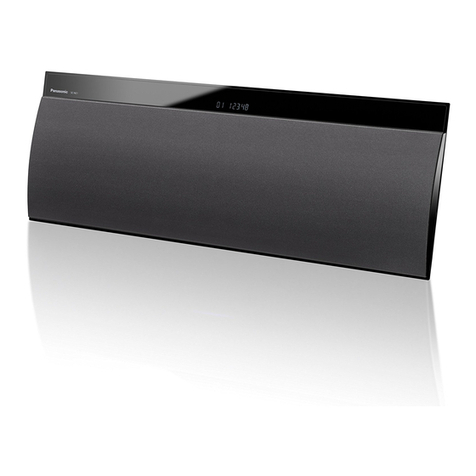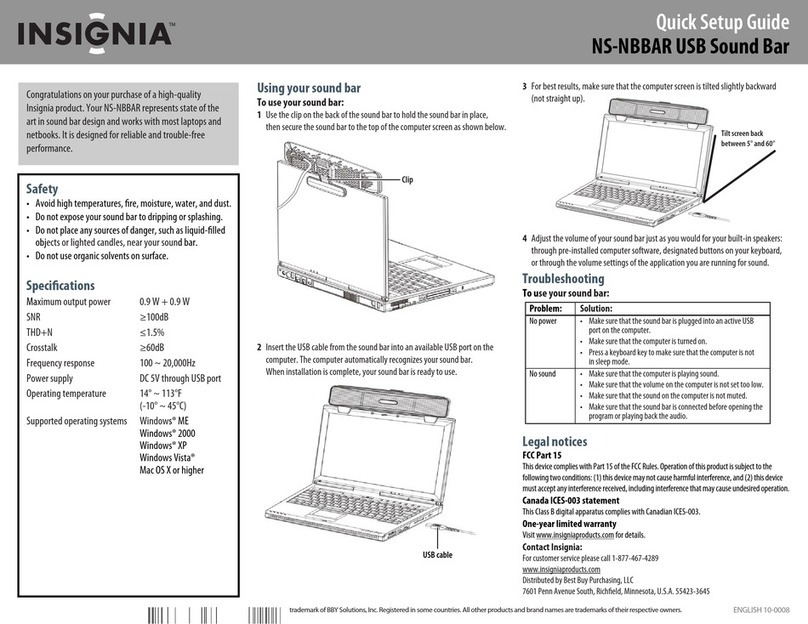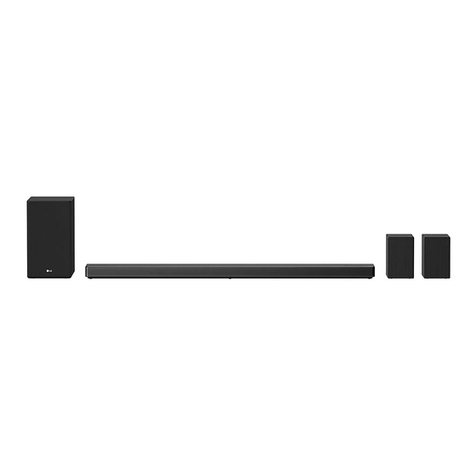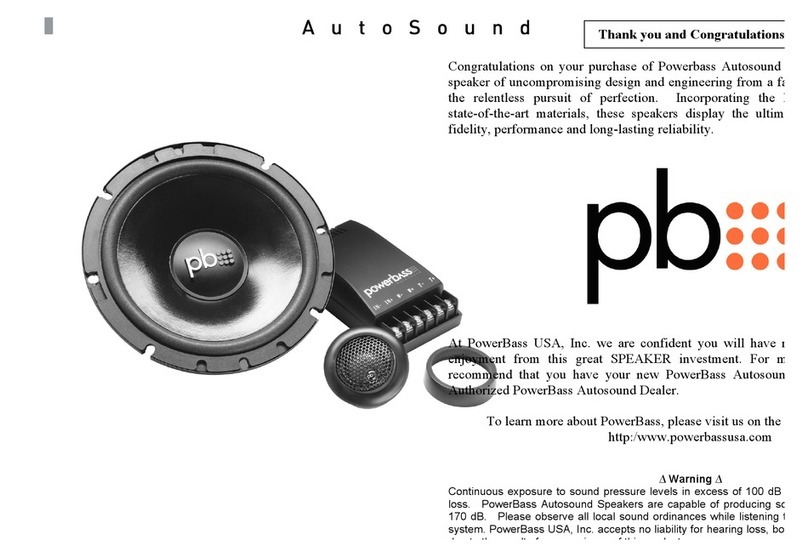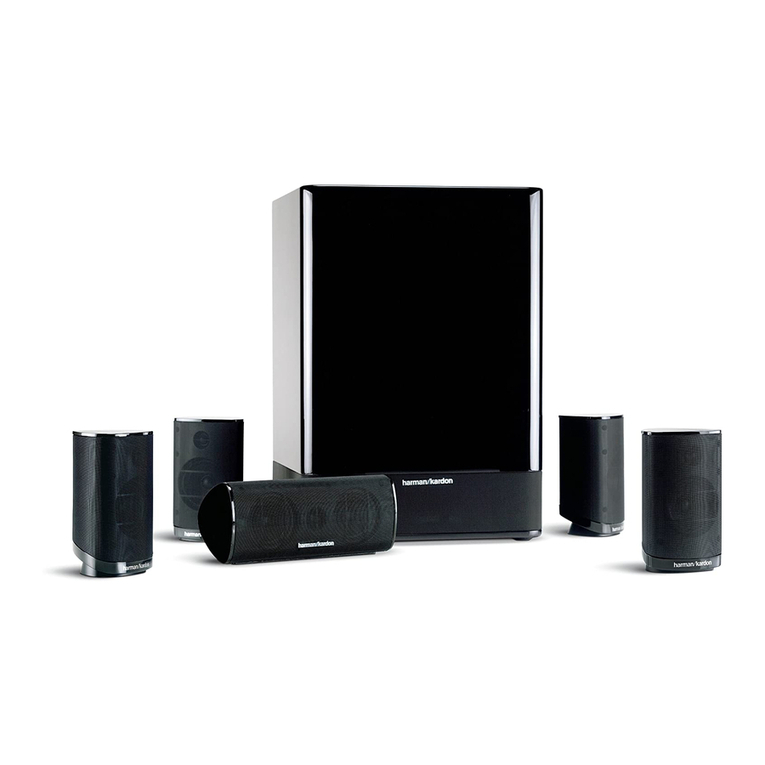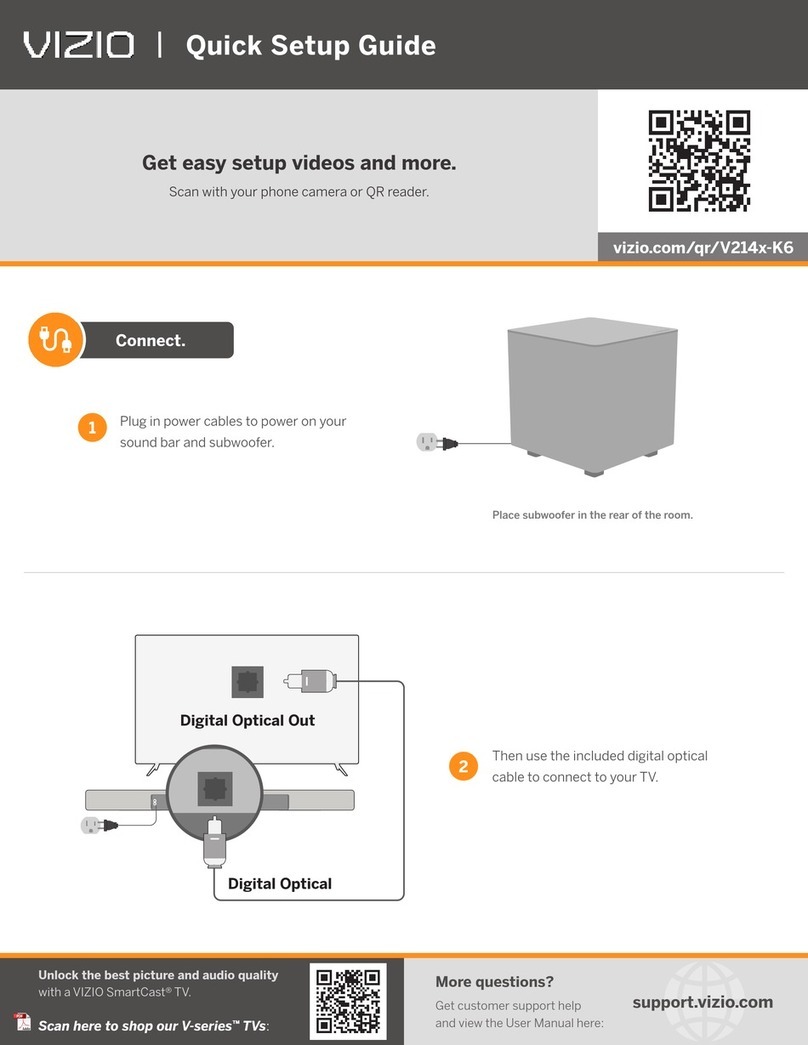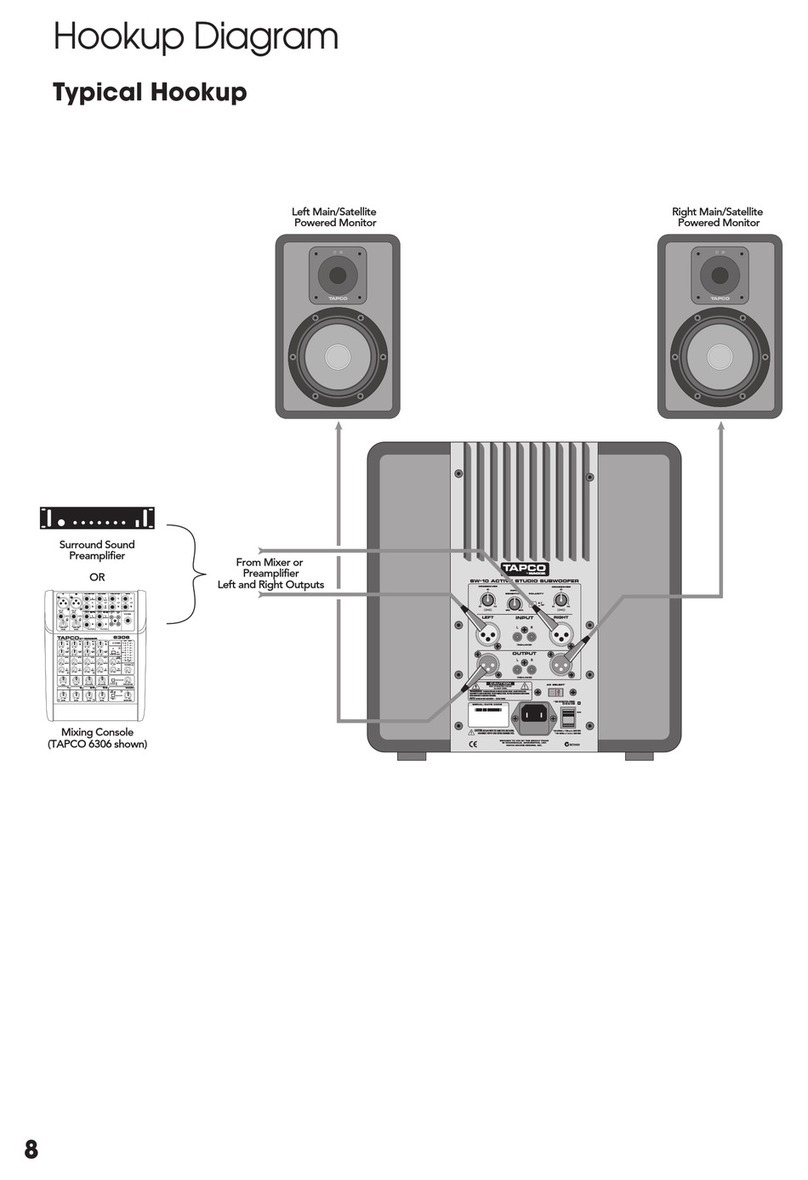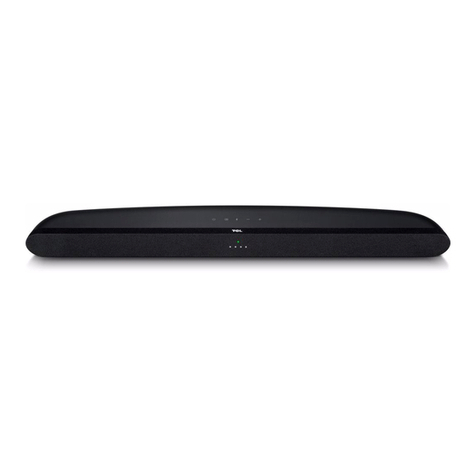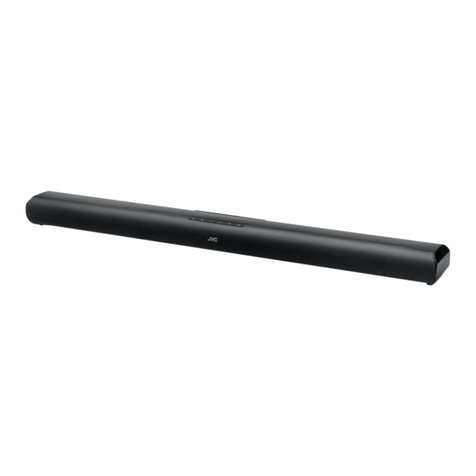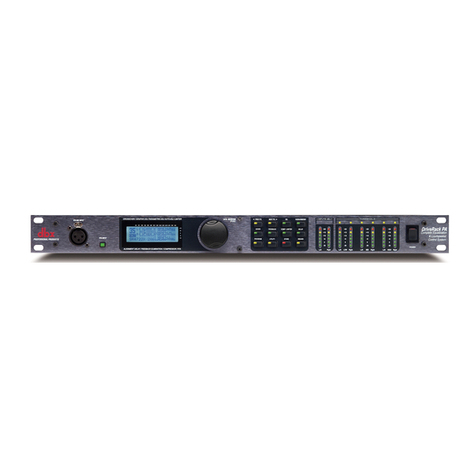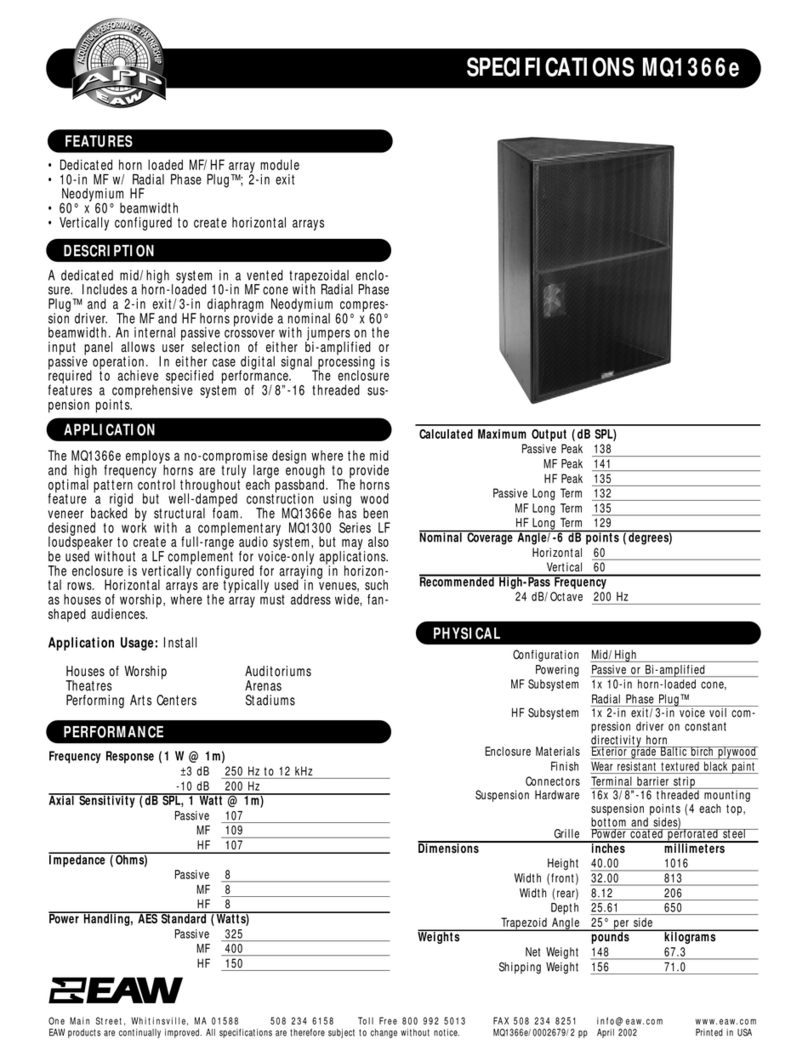The Speaker Company Home Theater Speaker User manual


TheSpeakerCompanyHomeTheaterSpeakerSystem Page2
Thelightningflashwitharrowheadsymbolwithinanequilateraltriangleisintendedtoalerttheusertothepresenceofuninsulated“dangerous
voltage”withintheproductsenclosurethatmaybeofsufficientmagnitudetoconstituteriskofelectricshocktopersons.
Theexclamationpointwithinanequilateraltriangleisintendedtoalerttheusertothepresenceofimportantsafety
instructionsintheliteratureaccompanyingtheappliance.
WARNING:TOREDUCETHERISKOFFIREORELECTRICSHOCKDONOTEXPOSETHISAPPLIANCETORAINORMOISTURE.
1. Readtheseinstructions.
2. Keeptheseinstructions.
3. Heedallwarnings.
4. Followallinstructions.
5. Donotusethisapparatusnearwater.
6. Cleanonlywithdrycloth.
7. Donotblockanyventilationopenings.Installinaccordancewiththemanufacturer'sinstructions.
8. Donotinstallnearanyheatsourcessuchasradiators,heatregisters,stoves,orotherapparatus(includingamplifiers)thatproduceheat.
9. Donotdefeatthesafetypurposeofthepolarizedorgroundingtypeplug.Apolarizedplughastwobladeswithonewiderthantheother.Agroundingtype
plughastwobladesandathirdgroundingprong.Thewidebladeorthethirdprongareprovidedforyoursafety.Iftheprovidedplugdoesnotfitintoyour
outlet,consultanelectricianforreplacementoftheobsoleteoutlet.
10. Protectthepowercordfrombeingwalkedonorpinchedparticularlyatplugs,conveniencereceptacles,andthepointwheretheyexitfromtheapparatus.
11. Onlyuseattachments/accessoriesspecifiedbythemanufacturer.
12. Unplugthisapparatusduringlightningstormsorwhenunusedforlongperiodsoftime.
13. Referallservicingtoqualifiedservicepersonnel.Servicingisrequiredwhentheapparatushasbeendamagedinanyway,suchaspowersupplycordor
plugisdamaged,liquidhasbeenspilledorobjectshavefallenintotheapparatus,theapparatushasbeenexposedtorainormoisture,doesnotoperate
normally,orhasbeendropped.
14. Maintainaminimumdistanceof50mmaroundthefront,rearandsidesoftheapparatusforsufficientventilation.Theventilationshouldnotbeimpeded
bycoveringtheventilationopeningsorplacingonoraroundtheapparatusitemssuchasnewspapers,tablecloths,curtains,etc.
15. Nonakedflamesources,suchaslightedcandles,shouldbeplacedontheapparatus.
16. Theapparatusshallnotbeexposedtodrippingorsplashing.Noobjectsfilledwithliquids,suchasvases,shallbeplacedontheapparatus.
17. Eitherthepowerinletconnectorontherearoftheapparatusorthepowerplugatthewallmustremainaccessible,tobeabletodisconnectpowerfrom
theapparatus.
18. TocompletelydisconnectthisapparatusfromtheACMains,disconnectthepowersupplycordplugfromtheACreceptacle.

TheSpeakerCompanyHomeTheaterSpeakerSystem Page3
Thankyou.Andcongratulations!
OurthanksforbuyingyournewspeakersfromTSC.Wesincerely
appreciateyourconfidenceinusandourproducts.
PleasereadthisOwner’sManual!Itcontainsmanytipsongettingyour
newspeakerssetup,connected,andsoundingasgoodastheyshould.
Wehopeyoufinditclear,concise,andhelpful.
Again,thankyou.
OutoftheBox
Youshouldsavethecartonandtheinsertsyourspeakerscamein.You
mayneedtostoreorshipyourTSCspeakersinthefutureandthe
packagingisdesignedtoprotectthemfromdamage.
WhereShouldYouPutThem?
Werealizethattherealworld(familyopinions,roomtrafficpatterns,
etc.)willhavemajorimpactonwhereyouplaceyourTSCspeakers.
Thatbeingsaid,herearesomeguidelinesyoushouldfinduseful.
ForTSCbookshelf/centerchannel/surroundspeakers:
1) Shelfmounting.Logically,thismaybeyourfirstconsideration.
That’sfineiftheshelfissturdyenoughanddeepenoughtohold
yourspeakerssecurely.Rememberthattheshelfshouldbeat
least2”deeperthanthespeakeritselftoallowforcable
connections,etc.SoifyourTSCspeakeris13”deep,you’ll
needashelfabout15”deeptoholditsafely.
RememberthatmostTSCspeakersarebassreflexenclosures.
Somehaveportsontherearpanel. Becausetheportisvery
importantforproperbassreproduction,pleasedonotblockit.
Infact,ifyou’reshelfmountingyourspeakersandcanleave6”
to8”ofopenspacebehindtherearpanel,somuchthebetter.
2) Standmounting:Thisisyoursecondoptionandit’sanattractive
oneformanyowners. Ifyou’replacingyourTSCbookshelf
speakersonstands,youcanuseamateriallikeBluTack®,a
moldable,reusableadhesivecompound,tokeepyourspeakers
firmly(butnotpermanently)attachedtothestands.Ifyoucan’t
findBluTack,justaskyourneighborhoodhardwarestoreforthe
genericequivalent.
PlacingYourSpeakersProperly
MainSpeakers:Trytoputthemainspeakers(LeftandRightforstereo,
Left,Center,andRightforhometheater)alongthesamewallofyour
listening/viewingroom.Ifyoucanplaceyourspeakersalongthelong
wall,somuchthebetter.
Usethe“RuleofThirds”wheneverpossible. Thissuggeststhatthebest
placementforyourLeftspeakerisapproximately1/3ofthewayalong
thewallbehindyourspeakers.Similarly,thebestplacefortheRight
speakerisusually2/3ofthewayacrossthesamewall. Rememberthat
the“RuleofThirds”isaguidelineonly.

TheSpeakerCompanyHomeTheaterSpeakerSystem Page4
Makesurethatthespeakertolistening/viewingpositiondistanceisthe
sameforeachspeaker.
Someprofessionalsrecommendplacingthemain(LeftandRight)
speakerssothattheyformanequilateraltrianglewiththeprime
listening/viewingposition.
Thisisasclosetoidealasyoucanget.
Ifyourroomwon’tallowthis,don’tbeoverlyconcerned.
Justplaceyourspeakersasclosetothisidealaspossible
andenjoythesound.
Reflectionsfromsidewallshaveamajorimpactonyoursoundsotry
nottoplaceyourmainspeakersclosetothem.Trynottoplaceyour
mainspeakerssothey’reexactlythesamedistancefromtheclosest
sidewall.Abitofasymmetryhereisactuallypreferable.
WhenyoutakethetimetoproperlyplaceyourMainspeakers,you’ll
enjoybetter“imaging”(theapparentplacementofindividualinstruments
orvoices),andmoredepth.
CenterChannelSpeakers
Forahometheatersystem,placethecenterchannelspeakerbetween
yourLeftandRightspeakersasclosetoyourTVscreenaspossible.
Trytokeepthetweetersofallthreespeakers(Left,Center,andRight)
asclosetothesameheightaspossible. Tweetersat–orverycloseto
–yourseatedearlevelareideal. (Thismayposeachallengeifyou
havetoplaceyourCenterChannelspeakereitheraboveorbelowyour
TVscreenbutyoushouldn’tworrytoomuch.)
Trytoplacethecenterchannelspeakeratexactlythesamedistance
fromyourlistening/viewingpositionasthemainLeftandRight
speakers.Thishelpscreatethemostconvincingimage.
SurroundSpeakers
Surroundspeakerplacementischallenging.Ifyou’reusingapairof
TSCbookshelfspeakers,youhavetwooptions.
Ifyou’reprimarilyamusiclistener,placethemonthebackwallof
yourlistening/viewingroombutabitclosertothesidewallsthanthe
“RuleofThirds”indicates.Makesurethetweetersareatapproximately
thesameheightasarethetweetersofyourfrontLeft,Center,andRight
speakers.

TheSpeakerCompanyHomeTheaterSpeakerSystem Page5
Ifyou’reamoviefan,mountthesurroundspeakersontheside
walls flankingyourprimarylistening/viewingposition.Makesure
they’reslightlybehindyourcouchorchairandatleast1.5to2’above
earlevel.
Trynottoplacefurniturebetweenyourspeakersandyour
listening/viewingposition.Makesureyoucanseeallyourspeakers
whenseatedthere.
SubwooferPlacement
Subwoofersarenotaseasytoplaceproperlyassomepeoplemight
haveyoubelieve.Althoughbassfrequenciesareomnidirectional(they
spreadevenlyintoaroom),youcannotplaceyoursubwoofervirtually
anywhereandenjoyqualitybassreproduction.
Herearesomepracticalhints.
· Formorebass,putthesubwooferinorclosetoaroomcorner.If
youdo,however,knowthattheresultingbassresponsewillmost
likelybeveryuneven.Somefrequencieswillbeemphasized.
Otherswillbesuppressed.Andthatpatternofexaggerationand
repressionwillchangeasyoumoveabouttheroom!
· Forabitlessbassbutmoreevenfrequencyresponse,movethe
subwooferawayfromthecorneralongonewall.
· Ifthatstilldoesn’tpleaseyou,thenmovethesubwooferfurtherout
intotheroom.You’llhavelessoverall“boom”butprobablyhigher
overallsoundquality.
Onceyou’vedecidedongeneralplacement,there’sanothertechnique
thatwillhelpyoufinetuneyoursubwoofer’sideallocation.
1. Identifyyourfavoritelistening/viewingposition.
2. PuttheSubwooferthere.(Yes,wemeanputitonorinyourfavorite
chairorsofa.Don’tworry,thefurniturewillhandletheweight.)
3. Playsomemusicorasoundtrackwithalotofbasscontent.
4. Crawlaroundtheroomonallfoursuntilyoufindtheplacewherethe
basssoundsthebesttoyou.
5. PuttheSubwooferthere.
ConnectingYourSpeakerSystem
Nowthatyouhaveyourspeakersplacedproperly,it’stimetoconnect
them.
Beforeyoubeginconnectingyour
speakers,turnyoursystem
componentsOFF.Thatway,youwon’t
runanychanceof“shorting”your
amplifierandpossiblydamagingitas
you’rehookingupyourspeakers.And,
ofcourse,turnyoursystembackON
whenyou’redone!
Method1(LineLevelConnection)
IfyoursurroundsoundreceiverhasalinelevelLFE(LowFrequency
Effects)output–sometimescalleda“subwoofer”output–connectitto
thesubwoofer’srearpanelSubwooferInputviaashieldedRCAtoRCA
cable.Seeyourreceiver’sinstructionmanualformoredetails.

TheSpeakerCompanyHomeTheaterSpeakerSystem Page6
Next,connectyourotherspeakers(Left,Center,Right,LeftSurround,
andRightSurround)directlytoyourreceiver.
Notethatyourreceiver’sspeakerconnectionsarepaired. One
terminalsineachpairisred(positiveor“+”),theotherblack(negativeor
““).
You’llnoticeapairofspringloadedterminalsoneachspeaker.They
arealsoredandblack,respectively.
Speakerwire,inturn,hastwoconductorsseparatedbyinsulationand
identifiedbycolor(iftheinsulationisclear)orbydifferencesinthe
insulationitself(ridgedvs.plainisthemostcommon).Chooseone
conductortocarrythe“+”signalandtheotherforthenegativesignal.It
makesnodifferencewhichoneyoupick–justmaintainthatchoice
forallyourconnections.
Preparethewirebyexposingabout3/8”ofeachconductorbyremoving
theinsulationwithawirestripperorsharpknife.Twistalltheindividual
strandsofeachconductortogether.
PolarityandProperPhasing
Don’tletthesewordsscareyou.Theybothrefertomakingsureyouget
allthesoundyourspeakersarecapableofgivingyou.
HerearestepbystepinstructionsforconnectingtheLeftfrontoutput
fromyourreceiveroramplifiertotheLeftfrontspeaker.
1) LocatetheLeftfrontspeakeroutputonthereceiveroramplifier.
Notethetwoconnectors–onemarked“+”(thepositiveterminal
–usuallyred)andonemarked““(thenegativeterminal–
usuallyblack).
2) Connectthe“+”conductorofthespeakerwiretothereceiver’s
“+”terminal.
3) Connectthe”“conductorofthespeakerwiretothereceiver’s“
“terminal.
4) Atthespeakerendofthesamewire,connectthe“+”conductor
tothe“+’terminalonthespeakerbypressingthespringloaded
tabtorevealaholeintheconnector.Insertthestrippedendof

TheSpeakerCompanyHomeTheaterSpeakerSystem Page7
thewireintothathole.Releasethetabtocompletethe
connection.
5) Connectthe““conductortothe““speakerterminal.
Thenfollowsteps1through5forallotheramplifierspeakerconnections
inyoursystem.Maintainthesamepatternforallamplifierspeaker
connections!
Whyareweplacingasmuchemphasisonconsistencyhere?Wewant
youtogetalltheperformanceyou’vepaidfor!
Whenyouramplifiertospeakerconnectionsareconsistent(when“+”is
alwaysconnectedto“+”and““isalwaysconnectedto““),your
speakersareconnected“inphase.”Thatmeansthedriversineach
speakerwillpushoutwhentheygetacommonpositivesignalfroman
amplifierandpullinwhentheygetanegativesignal.
Whenspeakersareconnected“outofphase,”thedriversfighteach
other–somemoveoutwhileothersmovein.Theresult?You’llget
lessbassandblurredimaging.That’saprettyheavypricetopayfornot
takingjustafewextrasecondstomakesureyourconnectionsare
correct.
SomeAdviceOnSpeakerWire
Pleaseuse16gaugewireifyouramplifiertospeaker
runsareunder50’.Forlongerruns,westrongly
suggest14gauge.
Foryourreference,standard“lampcord”availableat
mosthardwarestoresis18gauge.Bettertouse
heavierwiresuchas16or14gauge.
Method2(SpeakerLevelConnection)
IfyourreceiverdoesnothaveanLFEoutput,simplyconnectyour
receiver’sLeftandRightspeakeroutputstothesubwooferinputs
marked“FromReceiver.”
ThenconnectyourmainLeftandRightspeakerstothesubwoofer’s“To
Speakers”outputs.
Notethatallotherspeakers(CenterChannel,LeftSurround,andRight
Surround)connectdirectlytothereceiver’sspeakeroutputsastheydid
inMethod1above.
Makesureyouobserveproperpolarity(“+”to“+”and““to““)forall
connections.

TheSpeakerCompanyHomeTheaterSpeakerSystem Page8
AdjustingYourSubwoofer
Onceeverythingishookedupproperly,you’rereadyto“finetune”your
systemtoyourpreferences.
Thefollowingsuggestionswillgiveyouagoodstart.Rememberthat
theyaresuggestionsonly.Youmaychoosetovarythecontrolsettings
tosuityourroomandspeakerplacement.
· SettheCrossovercontrolto150Hz(allthewaytotheright).
Thiswilldirectmostofthedeepbassinformationtothe
subwoofer.
· SettheVolumecontrol(actuallya“basslevel”control)to
maximum.
· Select“AutoOn”bychoosingthemiddlepositionofthethree
positionsliderswitch.
· SetthePhaseswitchtonormal(NOR).
· PlayafavoritemusicCDorDVD.Concentrateontheamount
ofbassyouhearanddecideifyoulikethatsound.
· Ifyouthinkthere’stoomuchbass,turntheVolumecontrol
downuntilyou’resatisfiedwiththesound.(Youmayalsowant
totweaktheCrossovercontrolbyturningitslowlytotheleft.)
· Onceyou’repleasedwiththesound,flipthePhaseswitch
betweenNORandREV(reverse)toseeifthatmakesa
discernabledifference.
You’llprobablyhavetoplaywiththeseadjustmentsseveraltimesuntil
youachievejustthesoundqualityyoureallylike.Don’tworry–it’sjust
partofthefun.
BreakIn
Manypeoplebelievespeakersimprovewithage.
WithTSCspeakers,you’llnoticeachangeintimbre,responsiveness,
andsheermusicalityasyouusethembecausethedrivers“settlein”
withuse.
Howlongshouldyouwait?Thatdepends,forexample,onwhetheryou
listenAMradioatlowvolumeorfullorchestralmusicatliveconcert
levels.Ingeneral,you’llbegintoheardifferencesafter2030hoursof
us.
Care
YourTSCspeakersdon’tneedmuchmaintenance.Dustthem
occasionally.Anddon’tyourkidstrytopushinthedrivers,either!
Aboveall,enjoy!That’swhatyourTSCspeakersweredesignedforand
whywetakesuchprideinbringingthemtoyou!
©2007TheSpeakerCompany.Allrightsreserved.
www.thespeakercompany.com
